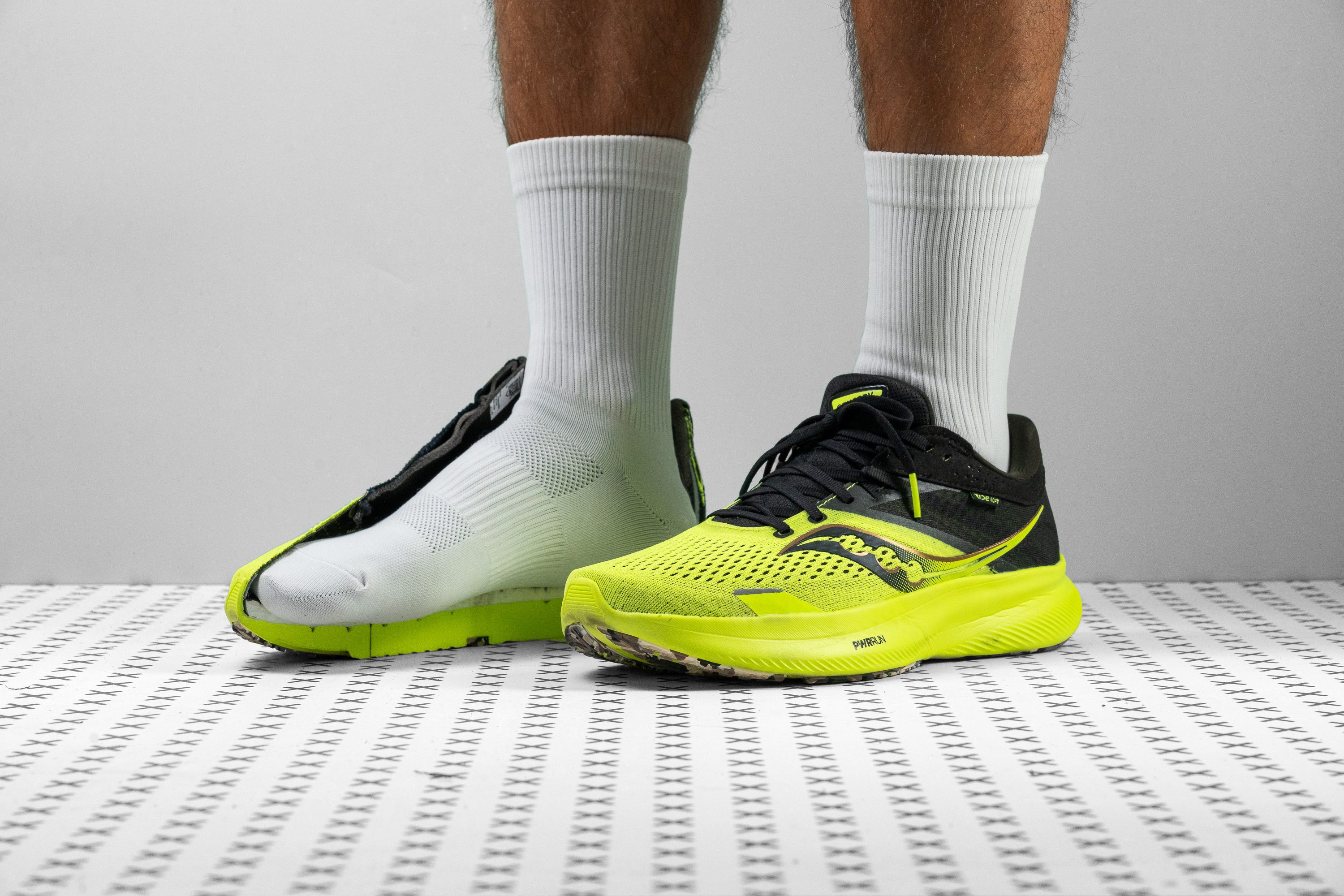Our verdict
- Top pick in best Saucony walking shoes (2023)
Pros
- Responsive and well-cushioned midsole
- Good for speedwork
- Excellent impact dampening
- Can gobble up miles
- Provides great stability
- Secure and comfortable lockdown
- Grippy and durable outsole capable of mild trails
Cons
- Upper durability leaves much to be desired
- Break-in period required
Audience verdict
Comparison
The most similar running shoes compared
+ + Add a shoe | |||||
|---|---|---|---|---|---|
| Audience score | 87 Great! | 88 Great! | 79 Good! | 89 Great! | |
| Price | $140 | $150 | $70 | $140 | |
| Pace | Daily running | Daily running | Daily running | Daily running | |
| Shock absorption | - | Moderate | Moderate | High | |
| Energy return | - | Moderate | Low | - | |
| Traction | - | High | Moderate | High | |
| Arch support | Neutral | Neutral | Neutral | Neutral | |
| Weight lab Weight brand | 9.3 oz / 264g 8.8 oz / 250g | 9.7 oz / 275g 9.8 oz / 277g | 9.7 oz / 275g 9.7 oz / 275g | 9 oz / 255g 9.5 oz / 269g | |
| Drop lab Drop brand | 7.9 mm 8.0 mm | 8.5 mm 10.0 mm | 7.8 mm 8.0 mm | 8.4 mm 8.0 mm | |
| Strike pattern | Mid/forefoot | HeelMid/forefoot | Mid/forefoot | HeelMid/forefoot | |
| Size | Slightly small | True to size | True to size | True to size | |
| Midsole softness | Balanced | Balanced | Balanced | Balanced | |
| Difference in midsole softness in cold | Big | Small | Small | Small | |
| Toebox durability | Bad | Decent | Bad | Decent | |
| Heel padding durability | Bad | Decent | Good | Good | |
| Outsole durability | Good | Decent | Decent | Good | |
| Breathability | Breathable | Moderate | Moderate | Breathable | |
| Width / fit | Narrow | Medium | Medium | Medium | |
| Toebox width | Medium | Medium | Medium | Medium | |
| Stiffness | Moderate | Stiff | Moderate | Moderate | |
| Torsional rigidity | Flexible | Moderate | Moderate | Flexible | |
| Heel counter stiffness | Stiff | Stiff | Stiff | Flexible | |
| Heel lab Heel brand | 33.3 mm 35.0 mm | 33.6 mm 39.0 mm | 31.2 mm 31.0 mm | 35.0 mm 37.0 mm | |
| Forefoot lab Forefoot brand | 25.4 mm 27.0 mm | 25.1 mm 29.0 mm | 23.4 mm 23.0 mm | 26.6 mm 29.0 mm | |
| Widths available | NormalWide | NormalWide | NormalWideX-Wide | NormalWide | |
| Orthotic friendly | ✓ | ✓ | ✓ | ✓ | |
| Season | SummerAll seasons | All seasons | All seasons | SummerAll seasons | |
| Removable insole | ✓ | ✓ | ✓ | ✓ | |
| Ranking | #303 Top 46% | #128 Top 35% | #320 Bottom 13% | #100 Top 27% | |
| Popularity | #394 Bottom 40% | #58 Top 16% | #78 Top 21% | #51 Top 14% |
Who should buy
We recommend the Ride 16 as a great choice for runners who:
- Want a daily trainer that’s flexible and suitable for speedwork
- Are just getting started and looking for a well-rounded, versatile shoe
- Want a well cushioned shoe that’s capable of going the distance

Who should NOT buy
For a shoe at this price-point, we expect more in terms of durability from the Ride 16. For runners who prefer a more heavy-duty daily trainer, we suggest having a look at the Nike Pegasus 40 instead.
The Ride 16 requires a few runs to fully break in the midsole, which does feel uncomfortably firm when fresh out of the box. While it does eventually yield to feel more plush, runners who want a shoe that’s good to go right out of the store, we recommend the Brooks Ghost 15 instead.
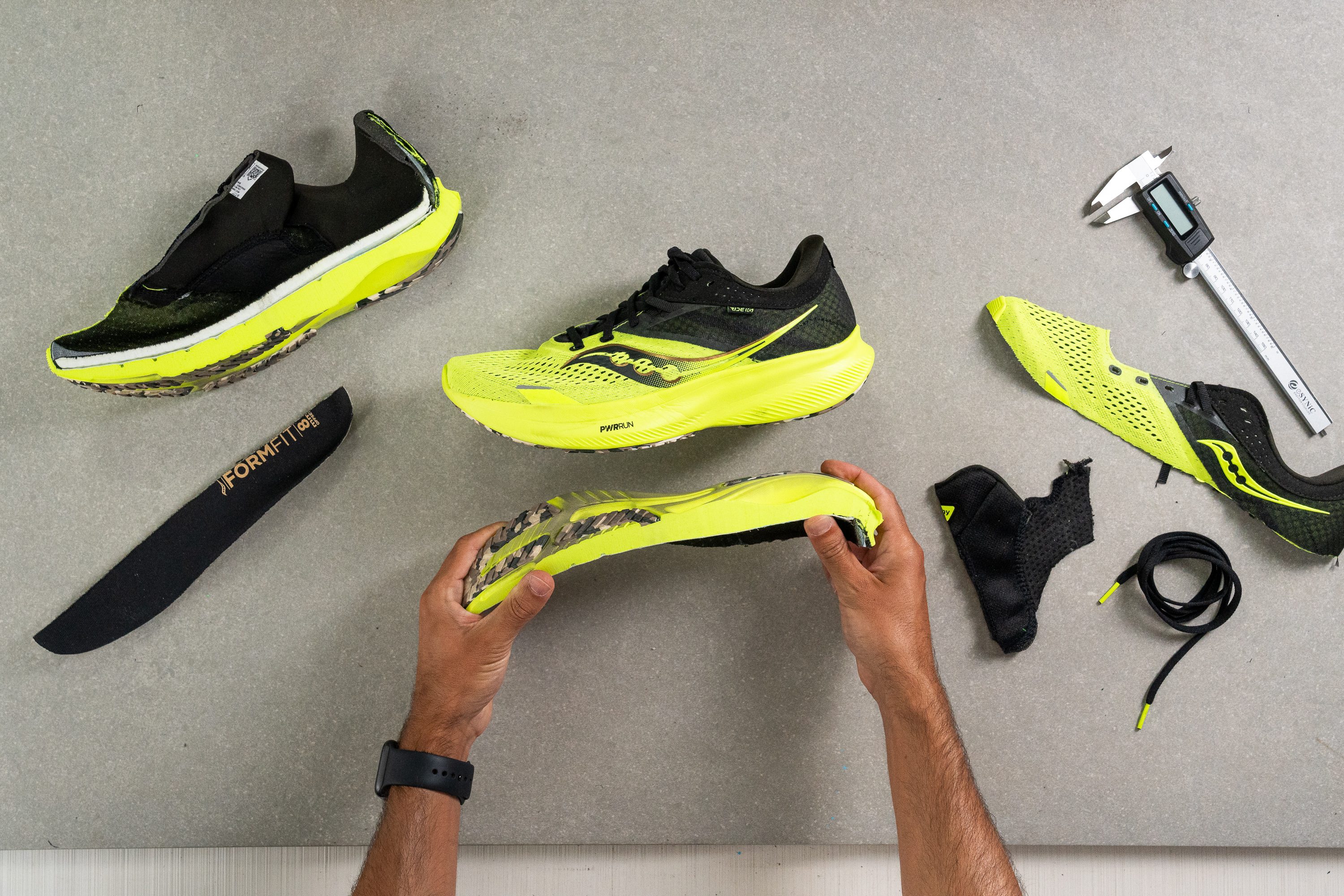
Cushioning
Heel stack
The Ride 16’s midsole is also 1.7 mm shorter than advertised by Saucony at the heel, with our caliper measuring it at 33.3mm. This falls within the average range and gives heel-striking runners plenty of foam underfoot for good impact protection.

| Ride 16 | 33.3 mm |
| Average | 34.8 mm |
Forefoot stack
Using our caliper, we measured the Ride 16’s stack to be 25.4 mm at the forefoot which is slightly shorter than the 27 mm stated by Saucony. This makes the shoe’s forefoot stack ever-so slightly higher than our current lab average and means that forefoot strikers have plenty of foam underfoot to ensure well dampened landings as well as peppy toe-offs.
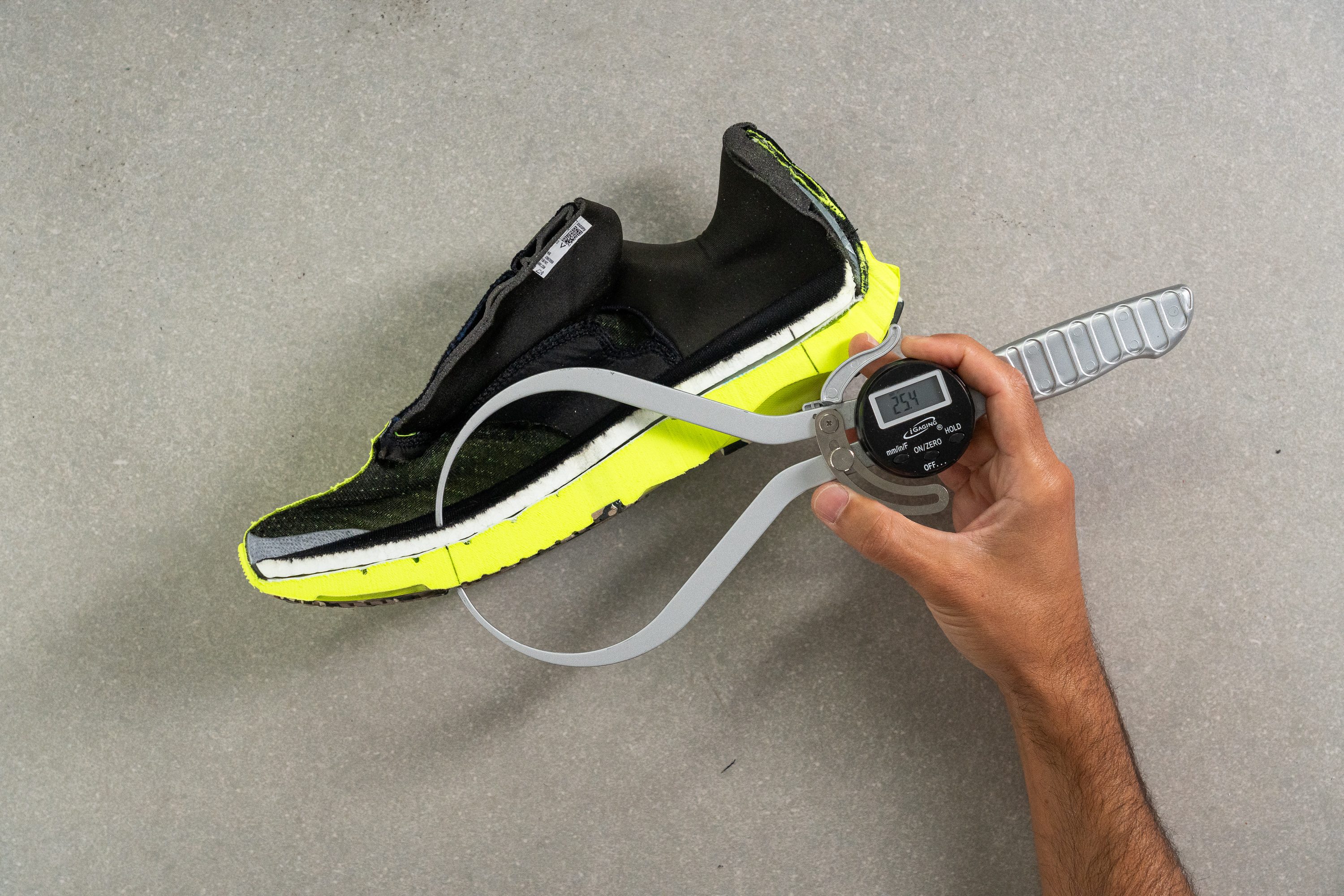
| Ride 16 | 25.4 mm |
| Average | 26.2 mm |
Drop
These stack measurements leave us with a drop height of 7.9 mm, which makes the 8 mm stated by Saucony pretty bang on despite the stack height discrepancies we found. This classifies the Ride 16 as a mid-drop shoe and makes it a good choice for most runners, whether forefoot or heel strikers and regardless of experience level.

| Ride 16 | 7.9 mm |
| Average | 8.6 mm |
Midsole softness
We pressed our durometer against the Ride 16’s midsole foam and got a reading of 20.6 HA. This is considerably softer than our current lab average and puts the Ride 16 in the category of plush midsole cushions.
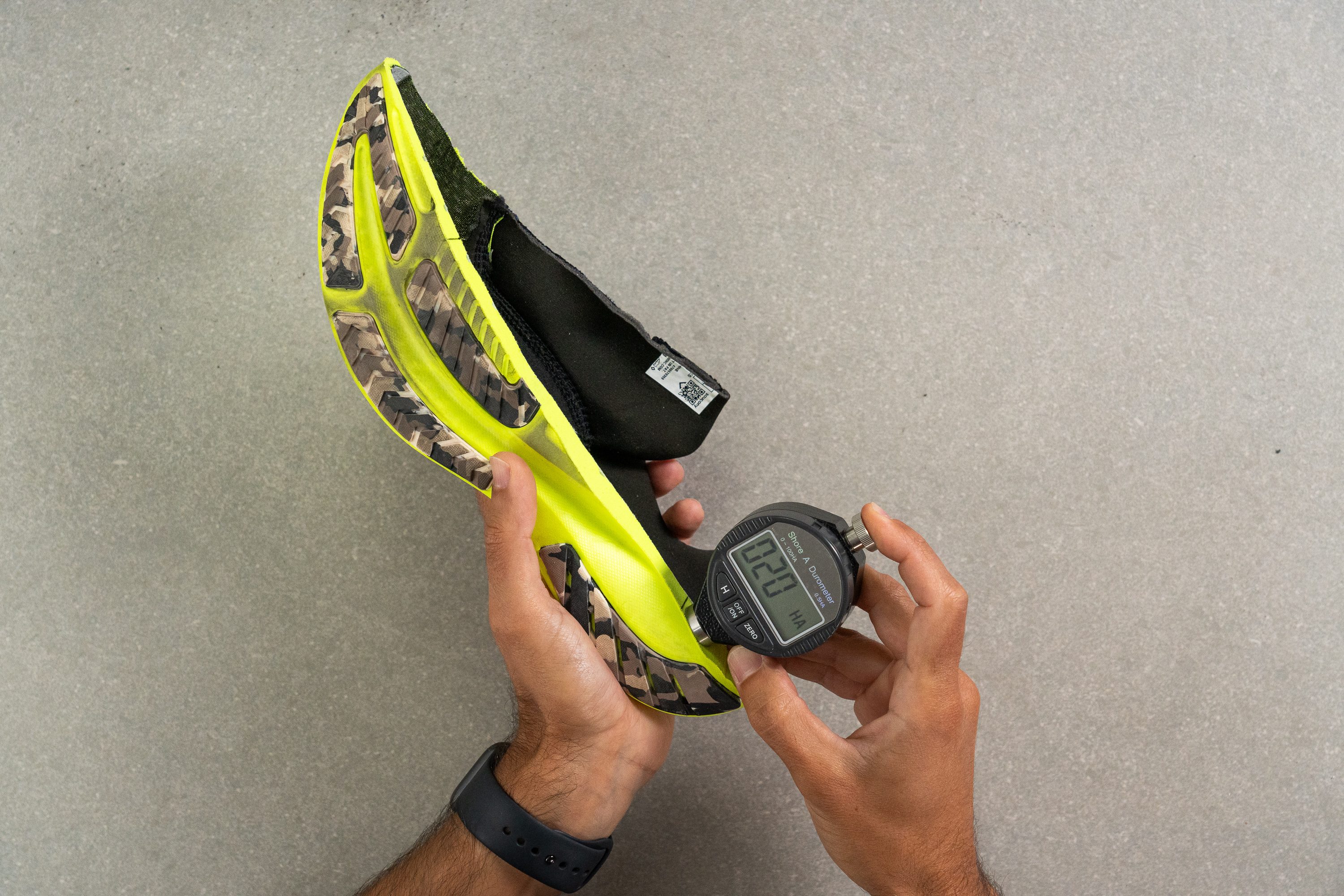
Despite this, the midsole foam didn’t feel too gummy underfoot and the shoe never bottomed out on us during our test runs. Instead the Ride 16 feels more balanced in terms of cushioning; with the foam providing great impact protection for long runs, and enough energy return to support speedier runs.
It must be said, however, that the Ride 16’s midsole has a break-in period. Our first couple of test runs felt rather stiff and uncomfortable underfoot until we were fully able to appreciate the shoe’s well-cushioned nature.
| Ride 16 | 20.6 HA |
| Average | 20.4 HA |
Size and fit
Size
Saucony Ride 16 fits slightly small (35 votes).
Width / Fit
We used our caliper to measure the Ride 16’s toebox and found it to be 97.2 mm at its widest point. This makes the toebox almost exactly as wide as our current lab average. The wide platform and stretchiness of the upper mesh, however, means that the Ride 16 is able to comfortably accommodate runners with broader feet.
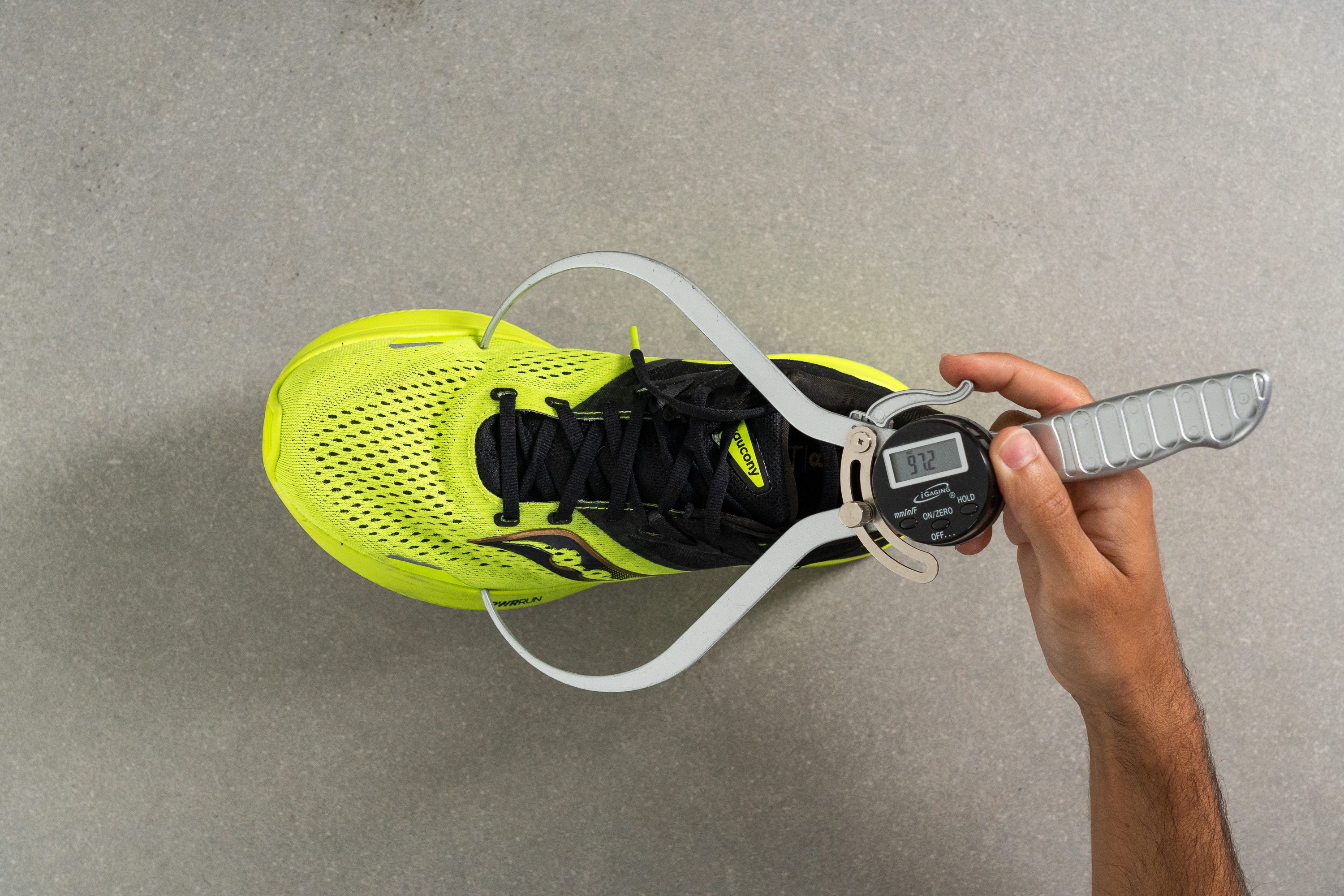
This test follows an older methodology, which is why you don't see recently tested shoes in the chart. Results from different methodologies can not be compared.
| Ride 16 | 97.2 mm |
| Average | 98.5 mm |
Toebox width
Moving up to the area around the big toe, we measured the Ride 16’s toebox to be 78.3 mm which is slightly wider than our lab average. This means that we have plenty of room to splay out naturally on landings without experiencing any pesky hotspots or blisters.

This test follows an older methodology, which is why you don't see recently tested shoes in the chart. Results from different methodologies can not be compared.
| Ride 16 | 78.3 mm |
| Average | 78.4 mm |
Flexibility / Stiffness
The Ride 16 disproves the notion that a shoe needs to be stiff in order to be fast. With only 15.6N of force required to bend the shoe 90-degrees, the Ride 16 is remarkably flexible compared to the average shoe. This allows the shoe to bend with the foot rather than wrestle it in place, making the Ride 16 a forgiving shoe whether we took it for easy or speedy test runs.
This test follows an older methodology, which is why you don't see recently tested shoes in the chart. Results from different methodologies can not be compared.
| Ride 16 | 15.6N |
| Average | 28.1N |
Stiffness in cold (%)
After leaving the shoe in the freezer for twenty minutes, we repeated the stiffness test and found that 20.5N is required to bend the shoe when exposed to cold conditions. This is still an incredibly flexible result that rivals the average shoe at room temperature! As such the Ride 16 will remain pliable and forgiving through even the most frigid runs.
Like most things, it’s normal for a running shoe to become stiffer in the cold but with only 31.1% loss of flexibility after the freezer, the Ride 16 is significantly more consistent than the average shoe under similar conditions.
| Ride 16 | 31% |
| Average | 33% |
Weight
With its beefier midsole, the Ride 16 is 0.4 Oz (11g) heavier than its predecessor, tipping our scale at 9.3 Oz (264g). The shoe still falls within the average range of road shoes we’ve tested so far, and never felt too bulky on our test runs.
| Ride 16 | 9.3 oz (264g) |
| Average | 9.3 oz (264g) |
Breathability
One thing’s for certain with the Ride 16, it’s a well ventilated shoe. It breezed through our smoke test where it seamlessly allowed the smoke to escape evenly throughout the shoe almost as soon as it was pumped in! This stellar performance leaves us no choice but to give the shoe a perfect 5 out of 5 for breathability.
Shining a light through a cross-section of the Ride 16’s upper illuminates just how effective the perforations in the toebox are. Apart from the fortified section on the side of the shoe, the light blasts clear through the airy upper mesh.
Our magnified view of the Ride 16’s toebox material shows a formation of loose braids woven in a way that maximizes airflow through the shoe
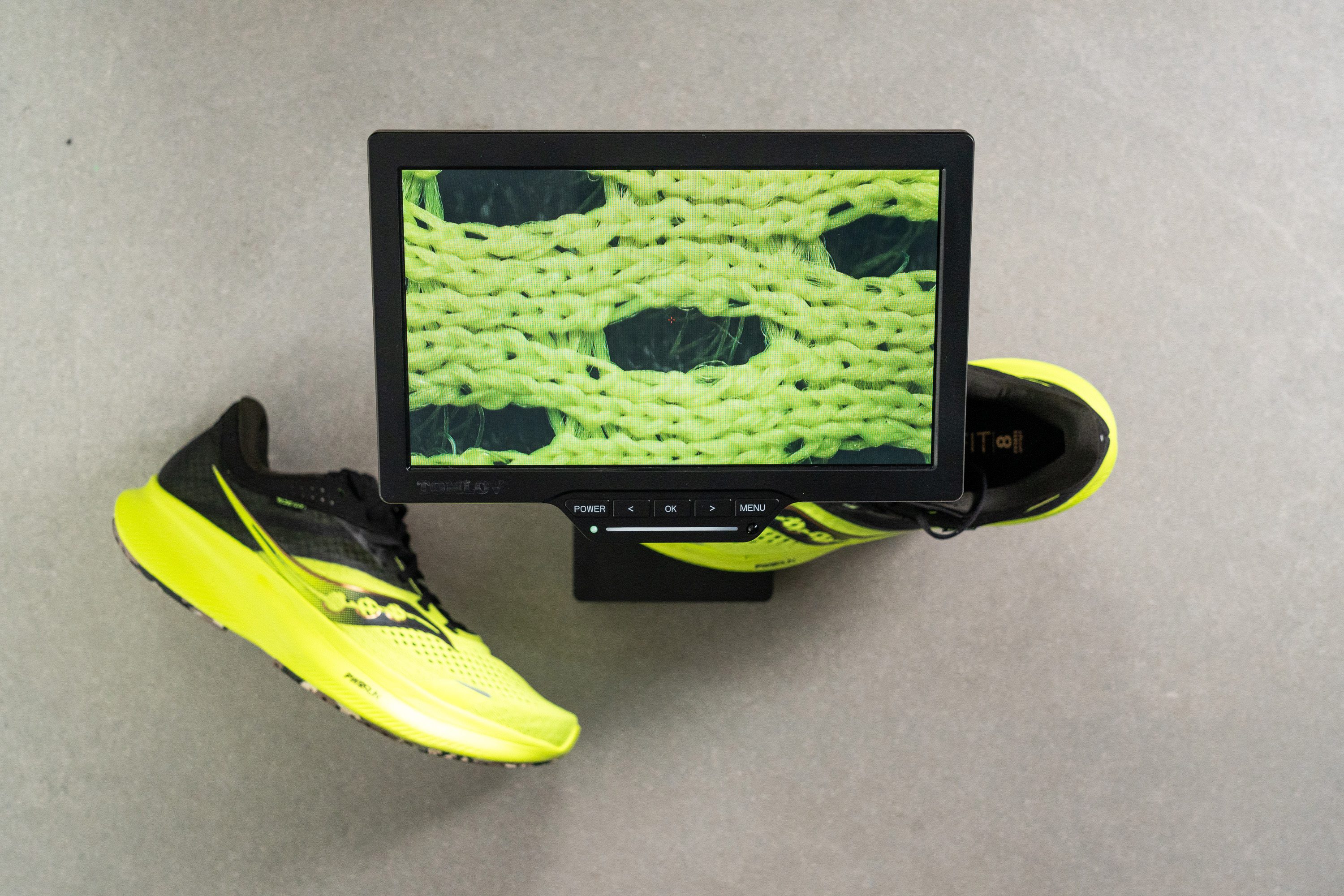

| Ride 16 | 5 |
| Average | 3.7 |
Stability
Lateral stability test
The mighty base of the Ride 16 kept us feeling so steady and sure-footed as we shifted our weight from side to side that we could have sworn it was a stability shoe! Our feet felt well-planted as we shifted our weight from side to side, with a little sway at the forefoot that facilitates taking corners smoothly.
Torsional rigidity
The Ride 16 put up almost no resistance as we twisted and manipulated it in our hands, giving it a score of 1 out of 5 which is much more flexible than we expect from a shoe with such a robust platform. This level of flexibility means that the Ride 16 easily bends and contorts with the movement of the foot rather than forcing it in place.
While the shoe may be stable enough for runners with mild pronation, those with more pronounced inward roll will be better served by a more rigid shoe with added stability features.
| Ride 16 | 1 |
| Average | 3.5 |
Heel counter stiffness
The Ride 16’s heel counter barely budged as we tried to pinch and squeeze it with our hands, leading us to give it a score of 5 out of 5. In practical terms, this means that the shoe does a good job of holding the rearfoot in place which is especially beneficial for heel striking runners, and again those with mildly pronating strides.
| Ride 16 | 5 |
| Average | 2.9 |
Midsole width - forefoot
Using our caliper, we measured the Ride 16’s midsole to be 124.3 mm wide at the forefoot. This makes the shoe’s midsole much wider than the average shoe, though we could have guessed that just by eyeballing it.

Despite this however, we didn’t find the Ride 16’s transitions to feel too blocky; likely a result of the almost tear-drop shaped taper in the shoe’s silhouette. This gives us a robust platform for forefoot landings and aerodynamic toe-off that feel smooth at any pace.
| Ride 16 | 124.3 mm |
| Average | 114.4 mm |
Midsole width - heel
Measuring 91.4 mm at the heel, the midsole falls closer to the average width of shoes we’ve tested in the lab so far and means that the shoe still has plenty of surface for steady heel landings.
This also means that the shoe tapers quite significantly towards the rearfoot, further contributing to the shoe’s aerodynamic design that helps the shoe flow smoothly at high speeds.
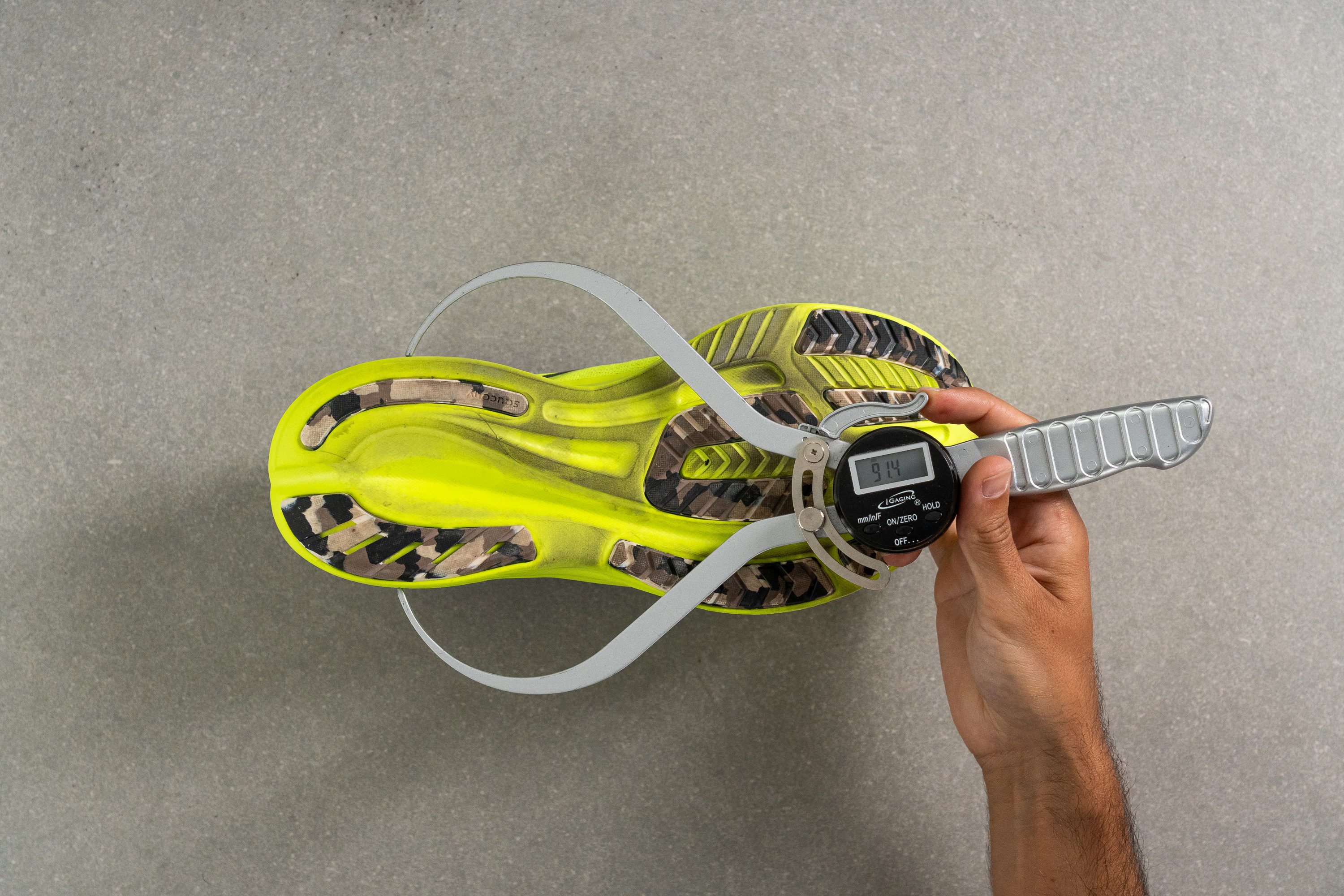
| Ride 16 | 91.4 mm |
| Average | 90.7 mm |
Durability
Toebox durability
The Ride 16’s toebox stood no chance against our dremel test. After subjecting it to a grinding force of 3.2N spinning at 10K RPM for four seconds, we had shredded our way clean through the upper material and left a gaping hole big enough for one of our toes to pop through. We therefore give the toebox a durability score of 1 out of 5.

So while the Ride 16 is capable of tackling mild park trail; we recommend steering clear of bushes or anything that might snag those large perforations in the toebox as it will likely send the shoe into an early retirement.
| Ride 16 | 1 |
| Average | 2.6 |
Heel padding durability
The shoe’s heel collar suffered a similar fate at the hands of our merciless dremel, which almost instantaneously sent bits of material and padding flying dramatically through the air. This also earns the heel padding a durability score of 1 out of 5, which leads us to predict that over 400 miles of heel friction will wear the padding down significantly.
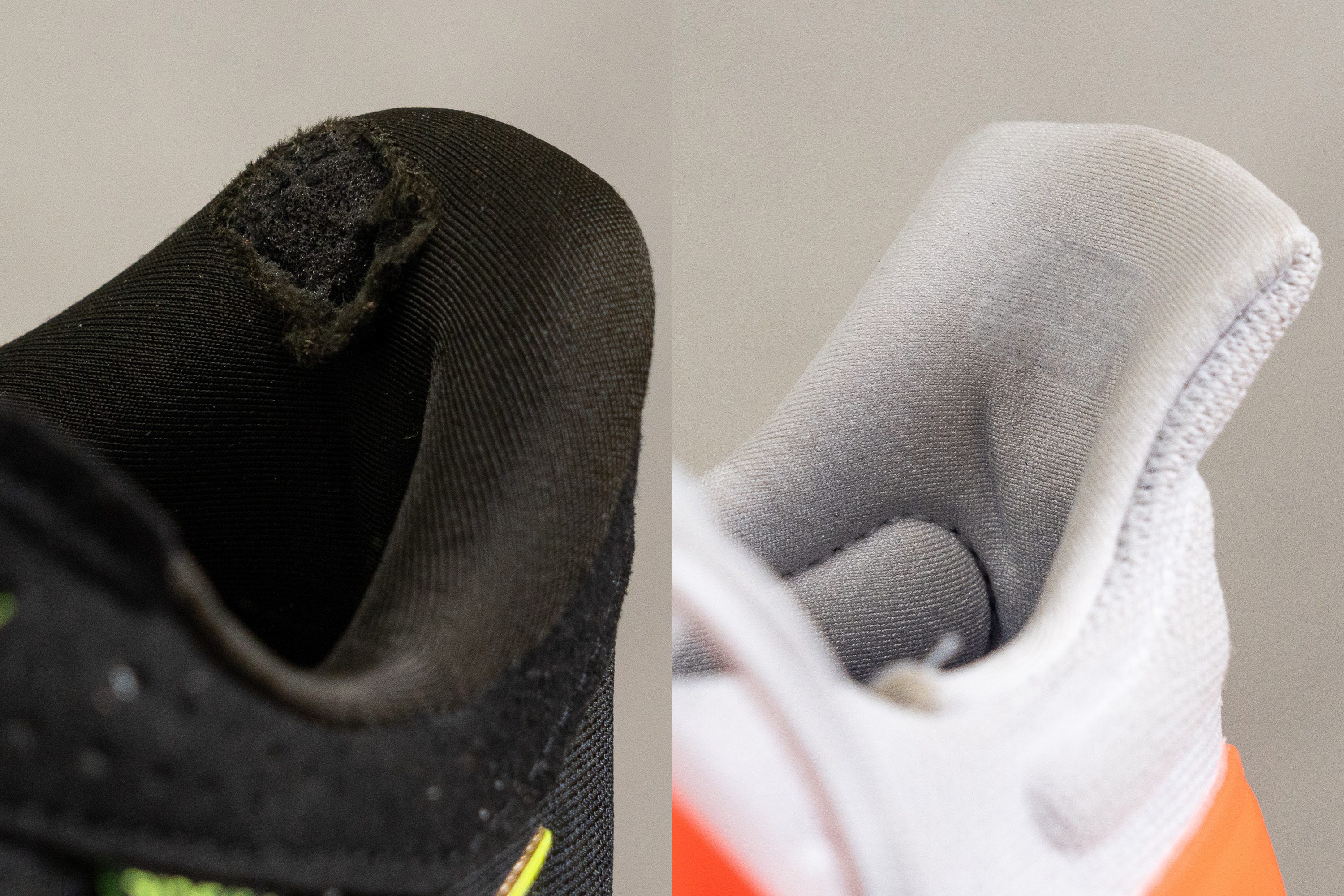
For a shoe that aces that same test, check out the Adidas Ultraboost Light's durable heel counter
| Ride 16 | 1 |
| Average | 3.4 |
Outsole hardness
We used our durometer to test how hard the shoe’s outsole rubber is and got a slightly higher than average reading of 83.9 HC. This somewhat hard reading implies a good level of durability but with enough softness to be able to bite into the ground and provide good traction.
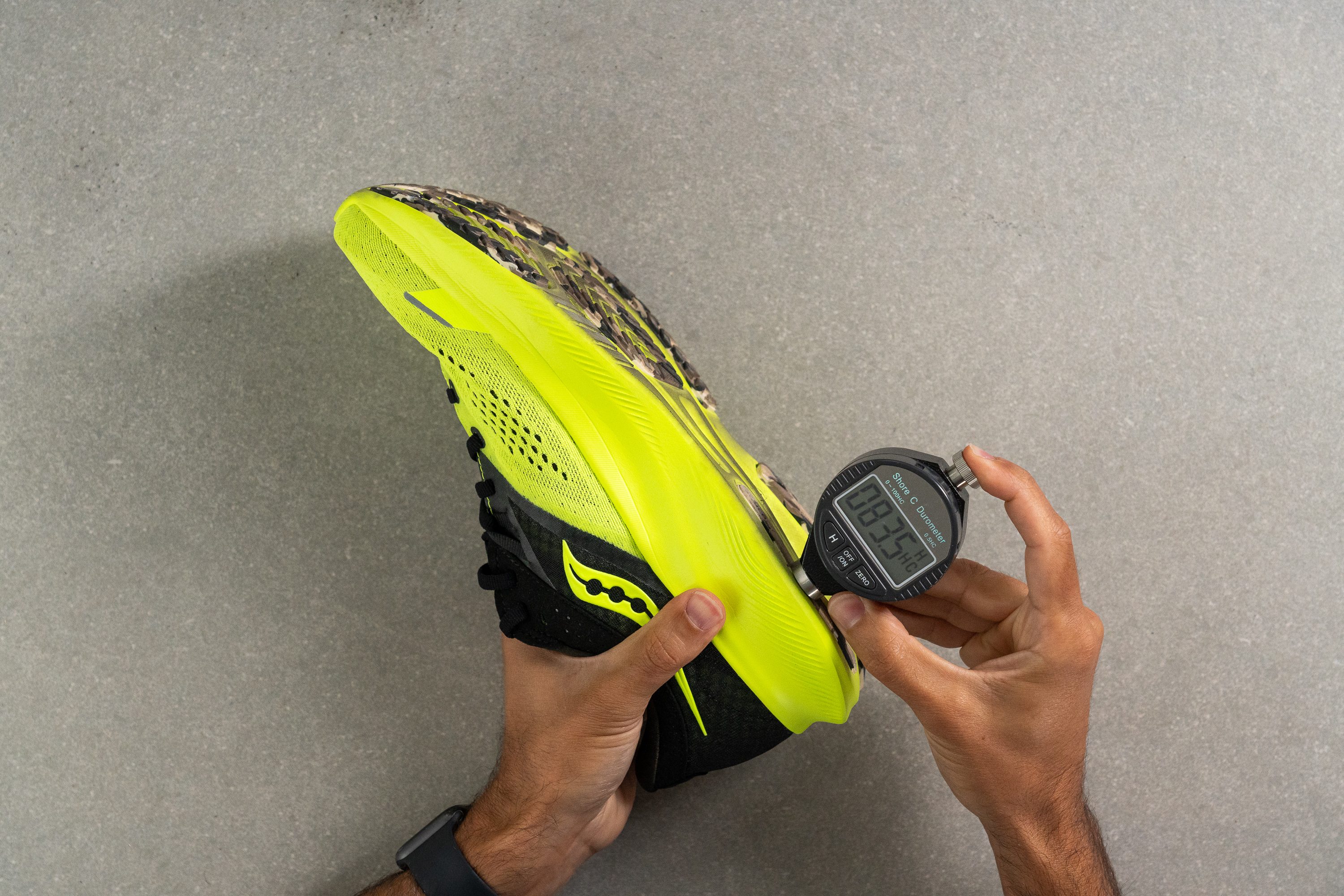
| Ride 16 | 83.9 HC |
| Average | 79.2 HC |
Outsole durability
Our prediction regarding the durability of the outsole based on the durometer reading proved true when we unleashed our undaunting dremel against it. The result of the twenty second test was a loss of only 0.7 mm of rubber from the Ride 16’s outsole.

Unlike the shoe’s upper components, the Ride 16’s outsole boasts above average durability, and means that we had no issue taking the shoe for runs on milder trails.
| Ride 16 | 0.7 mm |
| Average | 1.1 mm |
Outsole thickness
At 4.9 mm based on our caliper measurements, the Ride 16’s outsole is also beefier than that of the average shoe. We therefore predict that there should still be plenty of rubber left on the Ride 16’s outsole well past 500 miles of use.

| Ride 16 | 4.9 mm |
| Average | 3.2 mm |
Misc
Insole thickness
The Ride 16’s PWRRUN+ sock liner is quite plush, measuring 6.4 mm according to our caliper. This gives us an extra soft landing surface to land on within the shoe that nicely complements the soft midsole cushion.

| Ride 16 | 6.4 mm |
| Average | 4.5 mm |
Removable insole
The Ride 16 has a removable insole which makes it compatible with custom orthotics if needed.
| Ride 16 | Yes |
Midsole softness in cold (%)
To test how much firmer the midsole gets in cold weather, we popped the Ride 16 in our freezer. Twenty minutes later, we re-tested it with our durometer and got a reading of 30.0 HA. This is almost exactly as firm as the average shoe gets under the same conditions.
So while the Ride 16 will feel decidedly less plush during harsh winter runs, the midsole will still be soft enough to provide a balanced level of cushioning.
While we do expect midsole foams to become more firm in the cold, a differential of 45.4% means that the Ride 16 stiffens up by a higher margin than the average shoe. This tells us that the shoe will definitely feel very different underfoot between summer and winter.
For a shoe that remains incredibly plush all year round, we suggest having a look at the Adidas Supernova 2 instead.
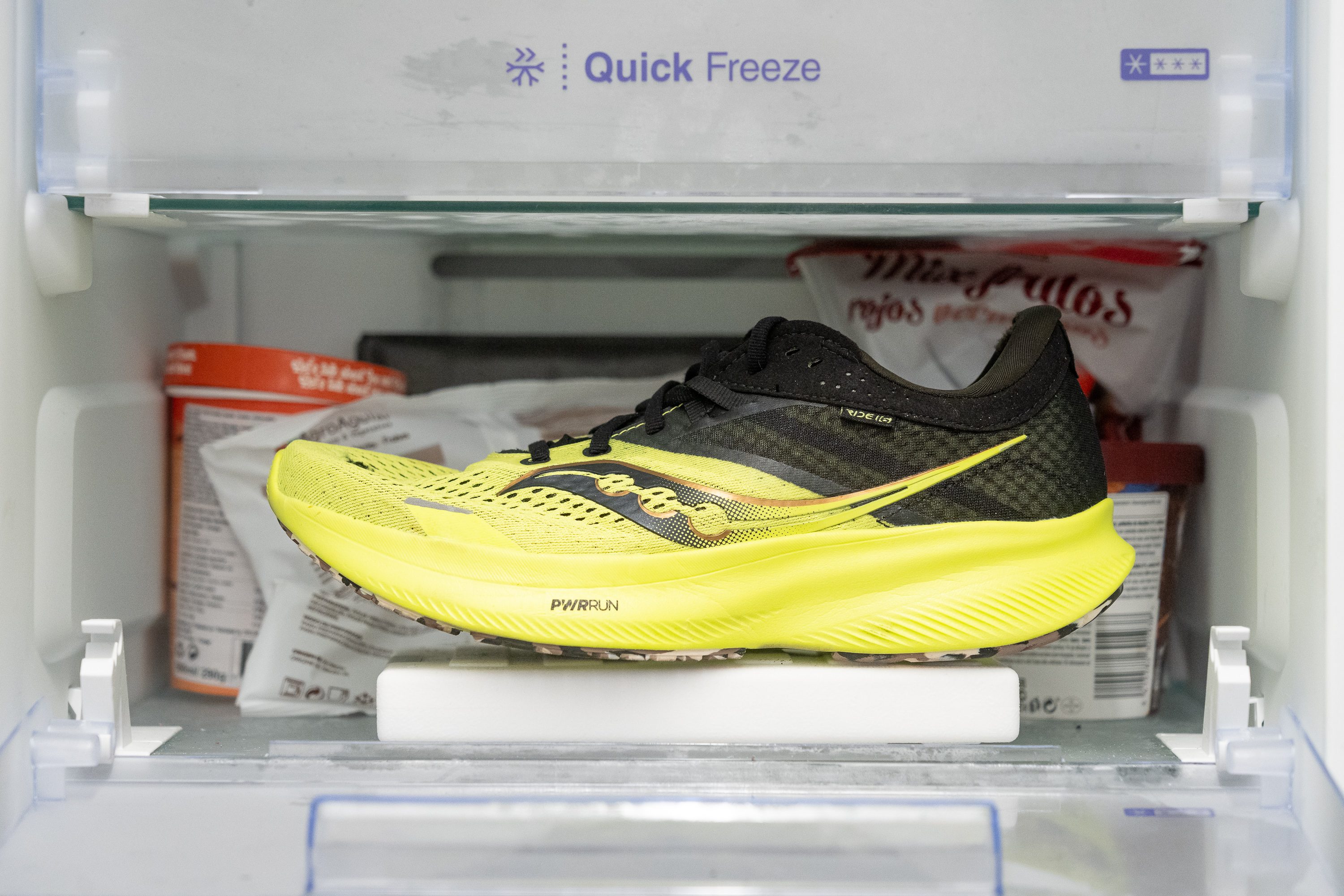
| Ride 16 | 45% |
| Average | 24% |
Reflective elements
With one speck along the side and three small dots on the rear, the Ride 16’s reflective elements are so minimal we wonder if they were worth including at all. We advise night owls to exercise caution when taking the shoe out for after hours runs.
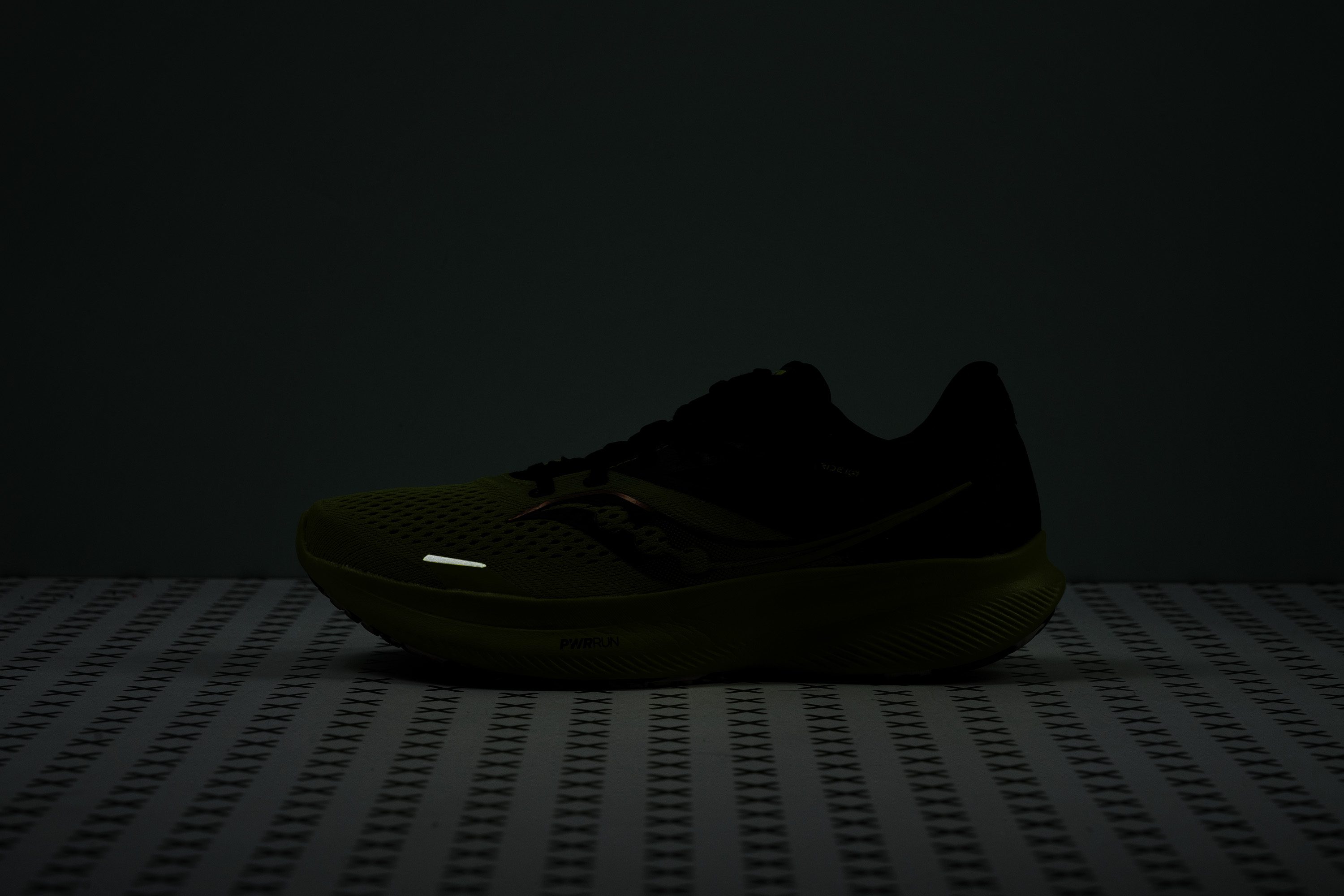

| Ride 16 | Yes |
Tongue padding
At 5.9 mm according to our caliper measurement, the Ride 16’s tongue falls right within the average range for shoes we’ve tested in the lab. This gives us enough padding to achieve a secure midfoot lockdown while avoiding any hint of lace bite.

| Ride 16 | 5.9 mm |
| Average | 5.8 mm |
Tongue: gusset type
The Ride 16’s tongue is semi gusseted on both sides, which allows it to wrap around our instep for an even more secure midfoot lockdown. This also meant that we didn’t experience any side-to-side slippage during our test runs.
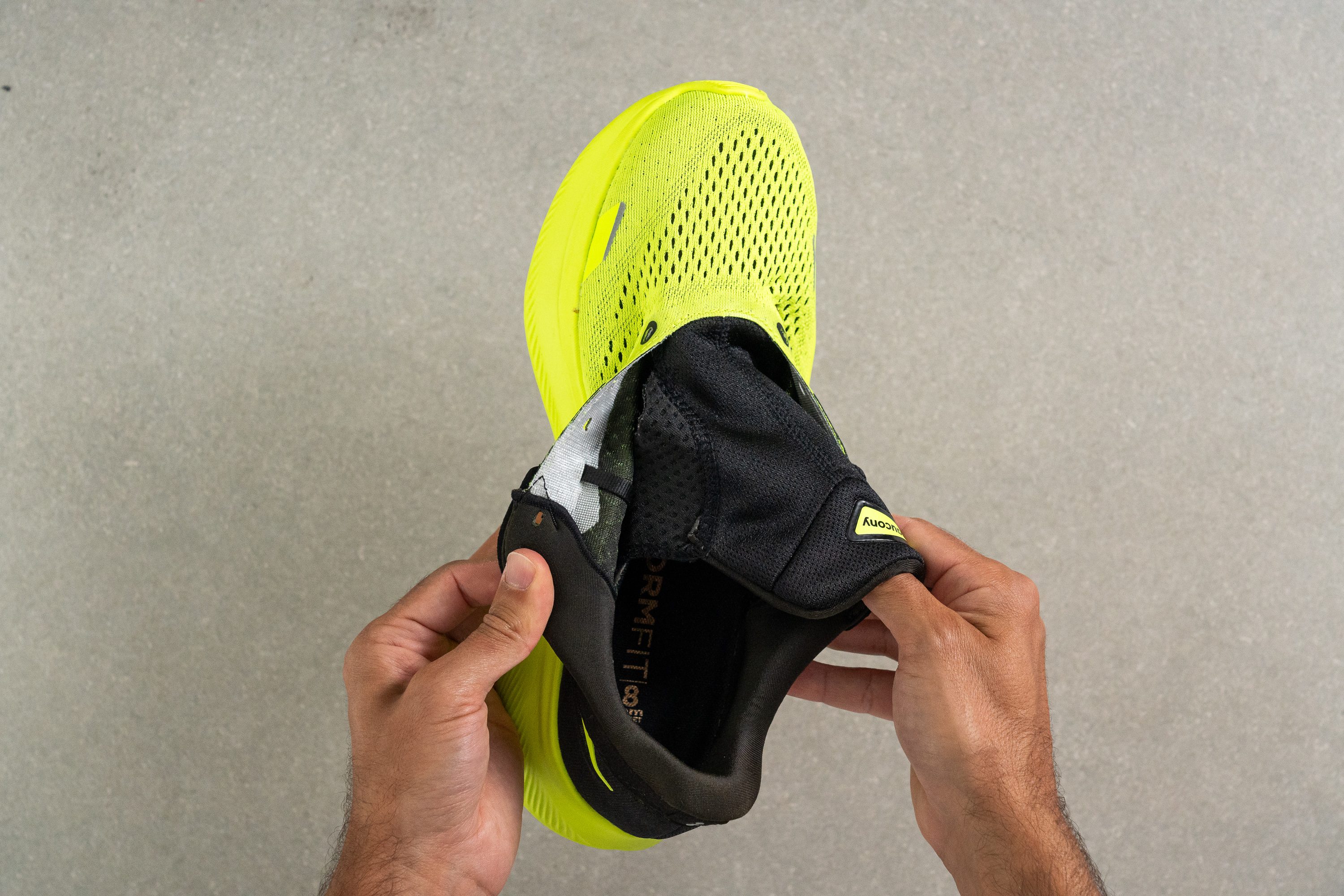
| Ride 16 | Both sides (semi) |
Heel tab
The Ride 16 doesn’t feature a heel tab, but the heel counter’s shape and flared “tail” make putting it on and taking it off a breeze.

| Ride 16 | None |

